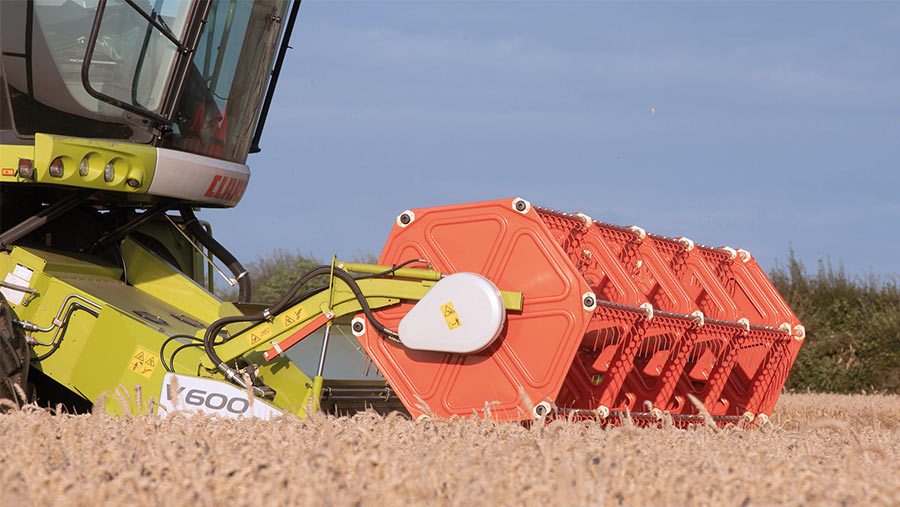Higher profits for 2022 harvest before a big dip in 2023
 © Tim Scrivener
© Tim Scrivener Higher working capital requirements for 2023 will eat into much-improved profits from this year’s harvest, challenging cashflow and reducing the scope for reinvestment.
With the value of wheat in the ground having risen by more than 50% since drilling, harvest 2022 looks set to be a very profitable one for the many who bought inputs before the bulk of the recent price rises, said farm business consultant Andersons.
The firm’s 600ha Loam Farm Model is budgeted to make a surplus from production of £677/ha from harvest 2022.
See also: Agricultural transition – how to make your arable farm business more sustainable
This figure is after drawings of £82/ha, but before English Basic Payment Scheme (BPS) cash and is a marked improvement on the 2021 figure of £376/ha.
With all costs rising, this year’s provisional surplus comes entirely from higher crop prices.
Loam Farm results and forecasts |
||||
|
|
Harvest years |
|||
|
£/ha |
2020 (Result) |
2021 (Result) |
2022 (Provisional) |
2023 (Forecast) |
|
Output |
1,165 |
1,523 |
1,966 |
1,734 |
|
Variable costs |
370 |
390 |
460 |
840 |
|
Gross margin |
795 |
1,133 |
1,506 |
894 |
|
Overhead costs |
436 |
437 |
506 |
563 |
|
Rent and finance |
238 |
242 |
243 |
256 |
|
Drawings |
75 |
78 |
80 |
82 |
|
Margin from production |
46 |
376 |
677 |
-7 |
|
Basic payment (+SFI) |
233 |
197 |
163 |
128+40 |
|
Business margin |
279 |
573 |
840 |
161 |
|
Andersons Loam Farm Model is a 600ha business in a standard rotation of winter milling wheat, winter feed weed, winter oats, spring barley, and spring beans. It is based on real-life data from average farm performance. The land farmed is 240ha owned, with 360ha on a farm business tenancy. |
||||
Big drop in 2023 forecast
However, for the 2023 harvest Loam Farm is budgeted to make a loss of £7/ha before BPS payments, with variable costs predicted to jump from £460/ha for the coming harvest to £840/ha next year.
Reinvestment decisions will be complicated by the need to balance the tax implications of decent profits against much higher working capital needs for the 2023 crop.
Speaking at the Lamma show this week, Andersons senior agribusiness analyst James Webster said: “Farmers need to be more aware than ever about what is coming down the road. Not all the profit from 2021 and 2022 will be available for reinvestment, with much higher working capital requirements ahead for the 2023 season, at a time when BPS payments for all farms in England are set to fall by 35%.”
Andersons’ Agflation index, a weighted average of farm inputs, recently showed a 28% increase in the cost of production in March 2022 compared with the same month last year.
With uncertainty in global geopolitics dominating markets, elevated input costs look set to stay, said Mr Webster.
The high variable and fixed costs for the 2023 season mean cashflow is likely to be challenged, depending on the timing of sales.
Any reinvestment following the 2022 crop will require careful consideration, on the basis that it must generate a return or drive a cost saving, advised Andersons.
Budget for volatility
Budgets and cashflow forecasts also need to account for high levels of volatility, said Mr Webster.
“There will be a lot of outlay for the 2023 harvest before much income is drawn,” he said.
A resolution to the Russia-Ukraine conflict would likely see wheat and other commodity prices fall, although not necessarily to pre-conflict levels.
However, input prices may not fall as rapidly as output prices – for example, potash from Russia and Belarus may remain at elevated levels.
With the supermarkets apparently on a race to the bottom on consumer prices, some of the more intensive sectors such as potatoes, where there was a lack of transparency on pricing, would see particular challenges, said Mr Webster.
These included high machinery costs and labour issues.
Machinery depreciation is too high
There is still way too much machinery on many farms, with every farmed hectare of land in the UK carrying a £180 machinery and equipment depreciation charge, said Andersons, adding that there are still many opportunities for collaboration and joint ventures.
While the £1m annual investment allowance enables kitting up with 100% tax relief in year one, investments need to produce a return and/or an opportunity for a system change, it warned.
As BPS falls, some income can be made up with Countryside Stewardship and the Sustainable Farming Incentive, while Farming Investment Fund grants offer up to 40% of equipment costs, and free advice on coping with the loss of BPS is still available through the Defra Farming Resilience Fund.
